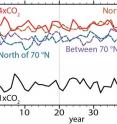Whitening the Arctic Ocean: May restore sea ice, but not climate
Related images
(click to enlarge)
Some scientists have suggested that global warming could melt frozen ground in the Arctic, releasing vast amounts of the potent greenhouse gas methane into the atmosphere, greatly amplifying global warming. It has been proposed that such disastrous climate effects could be offset by technological approaches, broadly called geoengineering. One geoengineering proposal is to artificially whiten the surface of the Arctic Ocean in order to increase the reflection of the Sun's energy into space and restore sea ice in the area. New research from Carnegie's Ivana Cvijanovic (now at Lawrence Livermore National Laboratory) and Ken Caldeira, as well as Douglas MacMartin of Caltech, shows that while an incredibly large effort could, in principle, restore vast amounts of sea ice by this method, it would not result in substantial cooling. As a result, it would not be effective in keeping the ground frozen in the Arctic. Their findings are published by Environmental Research Letters.
"By the middle of the century, the Arctic Ocean is predicted to be ice-free during part of the year," lead author Cvijanovic explained. "This could create substantial ecological problems in the Arctic, including habitat range changes and loss of biodiversity."
Beyond this, it could also have devastating effects on human settlements of Arctic indigenous communities.
"However the problem is not only local -- a number of studies have indicated that Arctic sea ice loss can affect weather patterns across the northern midlatitudes, including Europe, most of North America, and much of Asia," Cvijanovic added.
The technological feasibility of various Arctic whitening ideas is very much up in the air. Proposals include floating grains or microbubbles that would reduce the absorption of the Sun's rays. But beyond whether they are even feasible, it is important to determine whether or not they would have the desired environmental impact if they were implemented.
Using specially developed model configurations, the team studies how Arctic whitening would be expected to play out in a world with four times the preindustrial amount of atmospheric carbon dioxide , and an Arctic that is about 10 degrees Celsius hotter (18 degrees Fahrenheit).
They found that these sorts of whitening methods could restore some amount of sea ice -- about three-quarters of a square kilometer of ice for every whitened square kilometer (or three-quarters of a square mile for every whitened square mile). However, the cooling achieved by ocean whitening is modest and appears unable to do very much to maintain permafrost and prevent the release of the greenhouse gas methane.
Another interesting finding is that ocean whitening and sea ice recovery is likely to affect the climate far outside the Arctic region.
"Ocean whitening and the sea ice recovery achieved in this way could lead to wetter and milder winter conditions in the southwestern United States and cooler conditions in the eastern United States," Cvijanovic explains.
"Simply put, our results indicate that whitening the surface of the Arctic Ocean would not be an effective tool for offsetting the effects of climate change caused by atmospheric greenhouse gas," Caldeira said. "Furthermore, it is not clear to me that there is a technologically feasible way of actually doing this, and even if you could do it, the direct negative consequences of reducing the amount of sunlight available to marine ecosystems could be huge."
The authors noted, however, that this sort of whitening approach could be effective on a smaller scale, perhaps in an individual bay or estuary, as opposed to a whole ocean.
Source: Carnegie Institution
Other sources
- Researchers breed Arctic cod; species vulnerable to warmingfrom PhysorgThu, 30 Apr 2015, 23:00:16 UTC
- Researchers breed Arctic cod; species vulnerable to warmingfrom AP ScienceThu, 30 Apr 2015, 22:00:08 UTC
- Whitening the Arctic Ocean: May restore sea ice, but not climatefrom Science DailyTue, 28 Apr 2015, 23:20:07 UTC
- Whitening the Arctic Ocean: May restore sea ice, but not climatefrom PhysorgTue, 28 Apr 2015, 19:51:39 UTC

